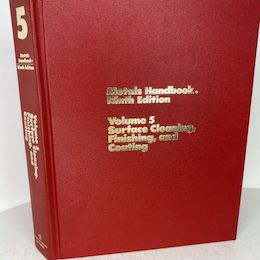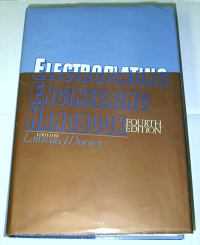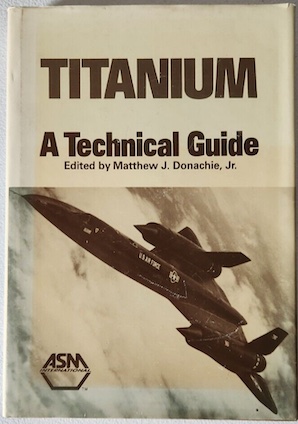
-----
Plating Copper onto Titanium
Q. Has anyone out there any experience with plating copper on titanium? We are presently experimenting before deciding on a set up, without much success. Any help would be appreciated.
Keith Anderson- Albuquerque, New Mexico, USA
2000
A. Titanium oxidizes very rapidly and its oxide will not plate with adhesion. Try to get a copy of Boeings or Pratt and Whitney or the USAF specification for plating on titanium. There is a workable process in Electroplating Engineering Handbook edited by Durney. It is not cheap, but is a valuable reference.
After several back and forth clean and activate steps you probably should give it a Wood's nickel strike and then copper strike then copper plate.
James Watts- Navarre, Florida
2000
2000
A. Hi Keith.
2. Rinse
3. Wet blasting
4. Activation in hydrochloric acid
5. Neutralizing in Rochelle salt ⇦ on eBay or Amazon [affil link] (Rocellcloric)
6. Plate copper in sulfuric acid.
Regards

Anders Sundman
4th Generation Surface Engineering
Consultant - Arvika,
Sweden
Multiple threads merged: please forgive chronology errors and repetition 🙂
2001
Q. Can someone help me with a copper plating problem?
I'm trying to plate copper on a titanium electrode in a solution of CuSO4, H2SO4 and a little HCl. The problem is that a very dark red (almost brown) very porous copper layer is formed on the titanium cathode. It is easily washed away with water after taking it out of the plating bath. It also seems like reaction tends to stop after a while, the current decreases when a constant voltage is used. When pH is low there is gas formation at the cathode, H2 I guess. What can I do to get solid bright copper?
Is it at all possible to plate copper onto a titanium electrode?
Do I have to change the electrolyte composition or use any additives?
My composition is:
[Cu] 300 mM = 75 g/litre
[H2SO4] 90 ml/litre (95% H2SO4, pH<0)
[HCl] 0,16 ml/litre
- Lund, Sweden
A. Hi Patrik,
The first thing you have a very bad adhesion for the copper to titanium, is difficult to plate on titanium. I have some different pretreatments method to do this activation. When the current decrease is the same as your anodes is passive no current will go through the anodes. I think you can see a black film on your anodes. About your pretreatment you must explain more about how you did your pretreatment step before the copper plating. To get a more brighter copper deposit you can try this method. 50 gr/l Copper sulphate, 180 gr/l kalium natrium tartrat (Rochelle salt), 50 gr/l Sodium hydroxide.
Regards,

Anders Sundman
4th Generation Surface Engineering
Consultant - Arvika,
Sweden
2001
A. Patrick,
Are you following the strict steps of activation in 3:1 HNO3-HF to red fuming and the dichromate? Are you controlling the HF content closely?. Your acid copper doesn't seem to be the problem. Please give us more info to better help.
Regards,
Guillermo MarrufoMonterrey, NL, Mexico
2001
2001
![]() Thank you very much for your advise.
Thank you very much for your advise.
As pretreatment I've been using this cleaning process for both titanium cathode and copper anode:
1. Thorough washing in detergent solution
2. NaOH 10%
3. H2SO4/HCl 10%
Rinsing after each step.
After your replies I've also been trying the activation process with 1:3 HNO3:HF solution. There was a reaction taking place with gas formation (green). It was obvious that the solution etches the outer layer of the titanium electrode, it was smaller afterwards. Is the purpose to remove a TiO2 layer?
Unfortunately the plating wasn't much more successful afterwards. I still get the very porous dark copper that falls apart. It seems like there is a thin bright copper layer right next to the cathode, but when running the process for a longer time it is also converted into this porous material. Two times I've succeeded getting a thin bright deposit, but only when running the plating for a short while.
I have the option of depositing another metal layer on top of the electrode and now I'm thinking of what metal to use. Platinum or palladium should be good I guess, I want it to be a good copper seed material and at the same time very inert in the electrolyte. Another option may be to make the whole electrode in stainless steel. What materials are the best when it comes to copper seed properties?
One last question, what current density range should be used for a bright solid deposit according to you?
Best regards,
Patrik Moller- Lund, Sweden
by N. Kanani
or Amazon
or AbeBooks
(affil link)
A. Hi Patrik. Although almost any plateable metal can be plated onto almost any plateable substrate, as a general rule it is probably best to plate more active metals onto more noble metals because you don't want the second metal to plate out spontaneously onto the first like copper sulphate ⇦ on eBay or Amazon [affil link] spontaneously plates out on an iron nail ... that will introduce still more adhesion issues :-)
You are certainly welcome to try to plate any metal onto titanium that you wish, whether you are a beginner or an expert with decades of broad experience. But if you are a relative beginner, please plate some steel with a Wood's nickel strike, then do the copper strike and copper plating that James Watts suggested. After you have succeeded in getting good copper plating onto this very easy substrate, then it may be time to come back and look at titanium again. The issue is simply that plating onto titanium is very difficult under the best of circumstances, and if you have little experience to guide you, it becomes impractical to try to decide what adjustments to make because there are so many interactive variables that you'll chase your tail. But good luck!
Regards,

Ted Mooney, P.E.
Striving to live Aloha
finishing.com - Pine Beach, New Jersey
Ted is available for instant help
or longer-term assistance.
Multiple threads merged: please forgive chronology errors and repetition 🙂
Q. I am working with an aerospace researcher who is trying to protect a titanium part from forming alpha case during super plastic forming (SPF) at 1100 °F. The part has holes in it that must be protected from the alpha case formation because etching to remove alpha case after the part is formed would make the holes too large. The holes can't be cut after forming because the shape and location of the holes would make it difficult after forming. We thought that if we plated the surface with copper to protect the titanium surface, it would allow us to form the shape using super plastic forming while preventing alpha case formation. After the SPF forming, we would strip the copper and be left with a pristine titanium surface.
We sent a sample to a local plating shop. They cleaned the panel, but were unable to get the copper plate to stick. They are not sure where their process went wrong. Before we send samples to other shops, we wanted to make sure we knew more about the processing required to get the plate to stick. Since we are concerned with the size of the holes, we can't etch the surface in preparation for plating. How do we prepare the surface to get the copper plating to stick?
If copper can't be plated on Titanium, is there another metal we could use instead that would hold up to the 1100 F and be ductile enough to bend with the titanium?
Factory Support Engineer - Auburn, Washington, USA
May 21, 2008
9th Edition, Vol. 5
"Surface Cleaning, Finishing & Coating"

on eBay or Amazon
or AbeBooks
(affil link)
A. Hi, Sue. It is hard to plate onto titanium. You might review ASM Metals Handbook, Vol. 5, "Surface Engineering", which has a good chapter on plating of titanium and refractory metals. This should give you some hints as to whether the requirements for plating onto titanium would conflict with your other requirements. Good luck.
Regards,

Ted Mooney, P.E.
Striving to live Aloha
finishing.com - Pine Beach, New Jersey
Ted is available for instant help
or longer-term assistance.
June 30, 2008
A. Hi,
The pretreatment steps (activating) for plating on titanium is to pretreat both alpha and beta phase with different activating steps in the titanium, so I don't think your needing to protect Alpha will help you when you copper plate on titanium.
I have an easy way to plate on titanium here which doesn't etch titanium too hard and is nice both to Alpha and the beta phase.
Method 1:
2.Rinse
3.Etching in hydrochloric acid time 3 minutes
4.Rinse in Rochelle salt acid
5.Copper strike 50 g/l and 160 Rochelle salt acid in 5 minutes 0,4 A/dm2
6. Rinse in sulfuric acid.
Method 2:
2. Rinse
3. Wet blasting with aluminium oxide carefully over the part.
4. Activation 325-450 g/l hydrofluoric acid 3 minutes after gassing.
5. Neutralising in 50g/l potassium tartrate
6. Copper strike See method 1
I will also recommend you to read the following from the literature and try to understand the problem with it.
M Thoma Plating on titanium Alloys 850716. MTU Motoren-and Turbinen-Union munchen GmbH,
M Thoma Plating on titanium. plating and surface finishing. May 1983 page 160-165.
C-G John, electroplated coating of Titanium for engineering Application. proceeding International Conference Designing With Titanium Institute Of metal, Page 191.
United States Patent 4,127,709. Metal and Finishing Guide book 2000, page 204.
E,W Turns, J,w Browing and R,L Jones Electroplates titanium Properties and effects, Plating and Surface Finishing. May 1973 page 443-451.
Regards,

Anders Sundman
4th Generation Surface Engineering
Consultant - Arvika,
Sweden
A. First, I would want to make sure that Ti and Cu do not form an intermetallic alloy at that temperature and pressure.
Years ago we had 4340 alloy copper plated to prevent decarburizarion of the surface during a heat treat cycle. It did not work very well and required thicker and thicker coats.
We eventually went to salt bath hardening which worked great.
So, even if you get copper to stick, There is no guarantee that you will not get alpha case. We got it several times welding in a bubble that had not been vacuum purged with an argon flow three times.
So, you have a challenging problem.
- Navarre, Florida
July 1, 2008
A. Superplastic forming(SPF)
"Superplastic alloys can be stretched at higher temperatures by several times of their initial length without breaking."
The only pure metal, ductile enough to meet this extreme condition is pure gold.
The only satisfactory adhesion I was able to deposit on a highly polish(mirror bright) pure titanium surface was by Physical Vapor Deposition(magnetron sputtering).The coating was a multilayer of titanium, titanium carbonitride, gold at several microns thick.
I'd check the internet for SPF titanium alloy compositions:, the types available: alpha, alpha + beta, beta.
Good luck,
- Mays Landing, New Jersey
July 10, 2008
Ed. note: Please see thread 40558 for a deeper treatment of "Adhesion of plating on titanium"
Q, A, or Comment on THIS thread -or- Start a NEW Thread

